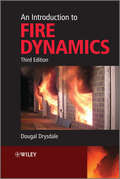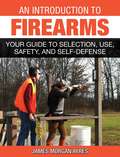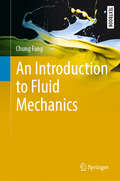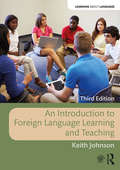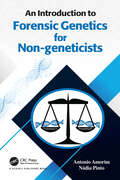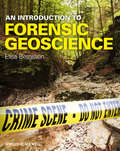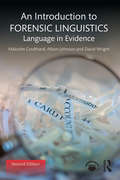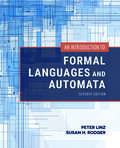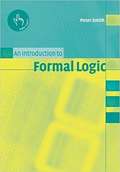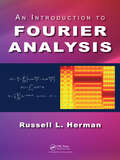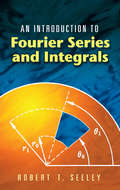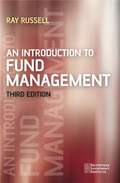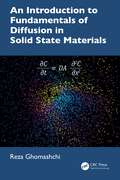- Table View
- List View
An Introduction to Fire Dynamics
by Dougal Drysdale"Drysdale's book is by far the most comprehensive - everyone in the office has a copy...now including me. It holds just about everything you need to know about fire science." (Review of An Introduction to Fire Dynamics, 2nd Edition)After 25 years as a bestseller, Dougal Drysdale's classic introduction has been brought up-to-date and expanded to incorporate the latest research and experimental data. Essential reading for all involved in the field from undergraduate and postgraduate students to practising fire safety engineers and fire prevention officers, An Introduction to Fire Dynamics is unique in that it addresses the fundamentals of fire science and fire dynamics, thus providing the scientific background necessary for the development of fire safety engineering as a professional discipline.An Introduction to Fire DynamicsIncludes experimental data relevant to the understanding of fire behaviour of materials;Features numerical problems with answers illustrating the quantitative applications of the concepts presented;Extensively course-tested at Worcester Polytechnic Institute and the University of Edinburgh, and widely adopted throughout the world;Will appeal to all those working in fire safety engineering and related disciplines.
An Introduction to Firearms: Your Guide to Selection, Use, Safety, and Self-Defense
by James Morgan AyresLearn everything you need to know to own and shoot firearms responsibly in this newly updated guide.Owning a firearm is a big responsibility. There's more to it than just walking into a gun shop and walking out with a gun. In addition to knowing state laws and regulations, you'll need to have the confidence to choose the right firearm for your needs and then learn to use it safely and effectively.An Introduction to Firearms goes beyond the basics, introducing you to the many uses of the gun, such as hunting, sporting competition, and self-defense, and includes resources for additional information on legal aspects of gun ownership, safety considerations, and gun manufacturers.Chapters of interest include coverage on: Where to Buy and Where to Shoot Hunting with Your Gun Care and Cleaning of Your Gun Gun Cabinets, Cases, and Safes Kids and Guns Defensive Shooting Skills Federal and State Gun Laws An Introduction to Firearms is the best guide available to you to ensure you have the right gun, whether you intend to use it for big game or self-defense. It's your right to own a firearm and your duty to use it responsibly.
An Introduction to Flapping Wing Aerodynamics
by Wei Shyy Hikaru Aono Chang-kwon Kang Hao Liu Wei Shyy Hikaru Aono Chang-Kwon KangThis is an ideal book for graduate students and researchers interested in the aerodynamics, structural dynamics and flight dynamics of small birds, bats and insects, as well as of micro air vehicles (MAVs), which present some of the richest problems intersecting science and engineering. The agility and spectacular flight performance of natural flyers, thanks to their flexible, deformable wing structures, as well as to outstanding wing, tail and body coordination, is particularly significant. To design and build MAVs with performance comparable to natural flyers, it is essential that natural flyers' combined flexible structural dynamics and aerodynamics are adequately understood. The primary focus of this book is to address the recent developments in flapping wing aerodynamics. This book extends the work presented in Aerodynamics of Low Reynolds Number Flyers (Shyy et al. 2008).
An Introduction to Fluid Dynamics
by G. K. BatchelorFirst published in 1967, Professor Batchelor's classic work is still one of the foremost texts on fluid dynamics. His careful presentation of the underlying theories of fluids is still timely and applicable, even in these days of almost limitless computer power. This reissue ensures that a new generation of graduate students experiences the elegance of Professor Batchelor's writing.
An Introduction to Fluid Mechanics
by Faith A. MorrisonThis is a modern and elegant introduction to engineering fluid mechanics enriched with numerous examples, exercises, and applications. It is based on Faith Morrison's vision that flows are both beautiful and complex. A swollen creek tumbles over rocks and through crevasses, swirling and foaming. Taffy can be stretched, reshaped, and twisted in various ways. Both the water and the taffy are fluids and their motions are governed by the laws of nature. The goal of this textbook is to introduce the reader to the analysis of flows using the laws of physics and the language of mathematics. This text delves deeply into the mathematical analysis of flows, because knowledge of the patterns fluids form and why they are formed and the stresses fluids generate and why they are generated is essential to designing and optimizing modern systems and devices. Inventions such as helicopters and lab-on-a-chip reactors would never have been designed without the insight brought by mathematical models.
An Introduction to Fluid Mechanics (Springer Textbooks in Earth Sciences, Geography and Environment)
by Chung FangThis textbook provides a concise introduction to the mathematical theory of fluid motion with the underlying physics. Different branches of fluid mechanics are developed from general to specific topics. At the end of each chapter carefully designed problems are assigned as homework, for which selected fully worked-out solutions are provided. This book can be used for self-study, as well as in conjunction with a course in fluid mechanics.
An Introduction to Food Grade Nanoemulsions (Environmental Chemistry for a Sustainable World #13)
by Shivendu Ranjan Nandita DasguptaThis book provides authentic and comprehensive information on the concepts, methods, functional details and applications of nano-emulsions. Following an introduction to the applications of nanotechnology in the development of foods, it elaborates on food-grade nano-emulsion and their significance, discusses various techniques and methods for producing food-grade nano-emulsion, and reviews the main ingredient and component of food-grade nano-emulsions. Further, the book includes a critical review of the engineering aspect of fabricating food-grade nano-emulsions and describe recently developed vitamin encapsulated nano-systems. In closing, it discuss the challenges and opportunities of characterizing nano-emulsified systems, the market risks and opportunities of nano-emulsified foods, and packaging techniques and safety issues - including risk identification and risk management - for nano-foods. The book offers a unique guide for scientists and researchers working in this field. It will also help researchers, policymakers, industry personnel, journalists and the general public to understand food nanotechnology in great detail.
An Introduction to Foreign Language Learning and Teaching
by Keith JohnsonAn Introduction to Foreign Language Learning and Teaching presents an engaging, student-friendly guide to the fields of foreign language learning and teaching. For students beginning their study of these fields, the book provides essential background information, dealing with language learning and teaching in a clear and comprehensible way. An Introduction will also be of value to teachers in training and those already working in the field, providing an up-to-date overview which focuses on contemporary issues while at the same time providing an important historical perspective. The book covers both theoretical and practical aspects of the field and provides suggestions throughout for discussion and workshop activities. Matters related to classroom and task-based teaching are dealt with at length, making the book suitable for use on practical training courses, especially where a degree of theoretical background is also required. Although most of the examples used deal with English as a foreign language, the book offers a suitable introduction for teachers of any foreign language. In this age of unfettered global communication the teaching and learning of foreign languages have never been more important. An Introduction to Foreign Language Teaching and Learning will give you the head start you need to get ahead of the field.
An Introduction to Foreign Language Learning and Teaching (Learning about Language)
by Keith JohnsonAn Introduction to Foreign Language Learning and Teaching provides an engaging, student-friendly guide to the field of foreign language learning and teaching. Aimed at students with no background in the area and taking a task-based approach, this book: introduces the theoretical and practical aspects of both learning and teaching; provides discussion and workshop activities throughout each chapter of the book, along with further reading and reflection tasks; deals with classroom- and task-based teaching, and covers lesson planning and testing, making the book suitable for use on practical training courses; analyses different learning styles and suggests strategies to improve language acquisition; includes examples from foreign language learning in Russian, French, and German, as well as English; is accompanied by a brand new companion website at www.routledge.com/cw/johnson, which contains additional material, exercises, and weblinks. Written by an experienced teacher and author, An Introduction to Foreign Language Learning and Teaching is essential reading for students beginning their study in the area, as well as teachers in training and those already working in the field.
An Introduction to Forensic Genetics
by Adrian Linacre William Goodwin Sibte HadiThis is a completely revised edition of a comprehensive and popular introduction to the fast moving area of Forensic Genetics. The text begins with key concepts needed to fully appreciate the subject and moves on to examine the latest developments in the field. Now illustrated in full colour throughout, this accessible textbook includes numerous references to relevant casework. With information on the full process of DNA evidence from collection at the scene of a crime to presentation in a legal context this book provides a complete overview of the field.Key Features:Greater in-depth coverage of kinship problems now covered in two separate chapters: one dealing with relationships between living individuals and the other covering identification of human remains. New chapter on non-human forensic genetics, including identification of bacteria and viruses, animals and plants. Self assessment questions to aid student understanding throughout the text. Now with full colour illustrations throughout New companion website Accessible introduction to forensic genetics, from the collection of evidence to the presentation of evidence in a legal context. Included in the Forensic Science Society 'Essentials in Forensic Science' book series. This edition is to be included in the Forensic Science Society 'Essentials of Forensic Science' book series aimed at advanced level undergraduates and new practitioners to the field.
An Introduction to Forensic Genetics for Non-geneticists
by Antonio Amorim Nádia PintoThis book aims to enable non-experts in Genetics to understand the contribution of this science to resolve civil or criminal litigations, analysing evidence of human and non-human origins. The main difficulties in the comprehension and misuse of the results of Forensic Genetics reside in the lack of effective communication between geneticists and the users of the produced information (as lawyers and judges) and do not arise primarily from the lack of knowledge of genetics. Therefore, instead of a classical handbook we use a question-and-answer approach, which meets this interfacial essence. Questions that can be addressed by genetic expertise are typified and for each of them we provide the possible expert report, presenting the essential biological and statistical genetics background in the form of boxes/appendices, along with exemplary cases. Legal, ethical, and theoretical limitations of Forensic Genetics are discussed, formulating questions that cannot, or should not, be addressed by this applied science.
An Introduction to Forensic Geoscience
by Elisa BergslienAn Introduction to Forensic Geoscience provides fundamental training in geoscience as developed through the lens of its forensic applications. It incorporates a range of topics including geophysical methods of grave detection, the mineralogy of art, identification of microfossils, and comparison of soil trace evidence samples. Each topic is introduced using core concepts that are developed with increasing complexity in order to give readers an understanding of the underlying scientific principles involved and a taste of the wide range of possible forensic uses. A variety of detailed reference tables have been compiled for the text and each chapter contains lists of references to applicable textbooks and journal articles. Examples of real criminal cases are also presented in each chapter to make the connections between theory and real world application. The goal of this book is to give readers a familiarity with the wide range of ways in which geoscience principles and geological materials can be utilized forensically. Additional resources for this book can be found at: http://www.wiley.com/go/bergslien/forensicgeoscience.
An Introduction to Forensic Linguistics: Language in Evidence
by David Wright Malcolm Coulthard Alison JohnsonAn Introduction to Forensic Linguistics: Language in Evidence has established itself as the essential textbook written by leading authorities in this expanding field. The second edition of this bestselling textbook begins with a new introduction and continues in two parts. Part One deals with the language of the legal process, and begins with a substantial new chapter exploring key theoretical and methodological approaches. In four updated chapters it goes on to cover the language of the law, initial calls to the emergency services, police interviewing, and courtroom discourse. Part Two looks at language as evidence, with substantially revised and updated chapters on the following key topics: the forensic linguist forensic phonetics authorship attribution the linguistic investigation of plagiarism the linguist as expert witness. The authors combine an array of perspectives on forensic linguistics, using knowledge and experience gained in legal settings – Coulthard in his work as an expert witness for cases such as the Birmingham Six and the Derek Bentley appeal, and Johnson as a former police officer. Research tasks, further reading, web links, and a new conclusion ensure that this remains the core textbook for courses in forensic linguistics and language and the law. A glossary of key terms is also available at https://www.routledge.com/products/9781138641716 and on the Routledge Language and Communication Portal.
An Introduction to Forensic Phonetics and Forensic Linguistics (Learning about Language)
by Paul Foulkes Ria Perkins Adrian Leemann Grace Sullivan BukerThis textbook provides a practical introduction to the fields of forensic phonetics and forensic linguistics. Addressing how these fields are both distinct yet closely related, the book demonstrates how experts from both fields can work together to investigate and deliver justice in complex legal situations.With pedagogical features including real-life case studies, exercises, and links to further reading, topics covered include:• Profiling from spoken and written texts;• Disputed meaning, and how meaning is made and evolves;• Interviewing techniques, including working around those who might be considered linguistically vulnerable;• Author and speaker determination;• Audio enhancement and authentication of recordings;• Language analysis in the asylum procedure (LAAP).Accompanied by online audio and video resources as well as signposting readers to freely available software to aid their studies, this book is the ideal springboard for students beginning work in forensic phonetics, forensic speech science, forensic linguistics, and law and language.
An Introduction to Formal Languages and Automata
by Peter Linz Susan H. RodgerAn Introduction to Formal Languages and Automata, Seventh Edition is designed for an introductory course on formal languages, automata, compatibility, and related matters forming what is known as the theory of computation.
An Introduction to Formal Logic
by Peter SmithFormal logic provides us with a powerful set of techniques for criticizing some arguments and showing others to be valid. These techniques are relevant to all of us with an interest in being skilful and accurate reasoners. In this highly accessible book, Peter Smith presents a guide to the fundamental aims and basic elements of formal logic. He introduces the reader to the languages of propositional and predicate logic, and then develops formal systems for evaluating arguments translated into these languages, concentrating on the easily comprehensible 'tree' method. His discussion is richly illustrated with worked examples and exercises. A distinctive feature is that, alongside the formal work, there is illuminating philosophical commentary. This book will make an ideal text for a first logic course, and will provide a firm basis for further work in formal and philosophical logic.
An Introduction to Fourier Analysis
by Russell L. HermanThis book helps students explore Fourier analysis and its related topics, helping them appreciate why it pervades many fields of mathematics, science, and engineering. This introductory textbook was written with mathematics, science, and engineering students with a background in calculus and basic linear algebra in mind. It can be used as a textbook for undergraduate courses in Fourier analysis or applied mathematics, which cover Fourier series, orthogonal functions, Fourier and Laplace transforms, and an introduction to complex variables. These topics are tied together by the application of the spectral analysis of analog and discrete signals, and provide an introduction to the discrete Fourier transform. A number of examples and exercises are provided including implementations of Maple, MATLAB, and Python for computing series expansions and transforms. After reading this book, students will be familiar with: * Convergence and summation of infinite series * Representation of functions by infinite series * Trigonometric and Generalized Fourier series * Legendre, Bessel, gamma, and delta functions * Complex numbers and functions * Analytic functions and integration in the complex plane * Fourier and Laplace transforms. * The relationship between analog and digital signals Dr. Russell L. Herman is a professor of Mathematics and Professor of Physics at the University of North Carolina Wilmington. A recipient of several teaching awards, he has taught introductory through graduate courses in several areas including applied mathematics, partial differential equations, mathematical physics, quantum theory, optics, cosmology, and general relativity. His research interests include topics in nonlinear wave equations, soliton perturbation theory, fluid dynamics, relativity, chaos and dynamical systems.
An Introduction to Fourier Series and Integrals
by Robert T. SeeleyA compact, sophomore-to-senior-level guide, Dr. Seeley's text introduces Fourier series in the way that Joseph Fourier himself used them: as solutions of the heat equation in a disk. Emphasizing the relationship between physics and mathematics, Dr. Seeley focuses on results of greatest significance to modern readers.Starting with a physical problem, Dr. Seeley sets up and analyzes the mathematical modes, establishes the principal properties, and then proceeds to apply these results and methods to new situations. The chapter on Fourier transforms derives analogs of the results obtained for Fourier series, which the author applies to the analysis of a problem of heat conduction. Numerous computational and theoretical problems appear throughout the text.
An Introduction to Fractional Differential Equations (Industrial and Applied Mathematics)
by K. BalachandranThis is an introductory-level text on fractional calculus and fractional differential equations. Targeted to graduate students of mathematics and researchers, it contains several new definitions of fractional integrals and fractional derivatives. With interesting applications of the subject in several areas of physical sciences, life sciences, engineering, and technology, the book helps the students understand the importance and developments of this topic. The book is enriched with a list of useful references to published literature, and the presentation of the book is entirely new and easily comprehensible to the students. Some of the topics are refined, and new examples are included to supplement theories to help students understand the concepts easily and clearly.
An Introduction to Frames and Riesz Bases (Applied and Numerical Harmonic Analysis)
by Ole ChristensenThis revised and expanded monograph presents the general theory for frames and Riesz bases in Hilbert spaces as well as its concrete realizations within Gabor analysis, wavelet analysis, and generalized shift-invariant systems. Compared with the first edition, more emphasis is put on explicit constructions with attractive properties. Based on the exiting development of frame theory over the last decade, this second edition now includes new sections on the rapidly growing fields of LCA groups, generalized shift-invariant systems, duality theory for as well Gabor frames as wavelet frames, and open problems in the field. Key features include: *Elementary introduction to frame theory in finite-dimensional spaces * Basic results presented in an accessible way for both pure and applied mathematicians * Extensive exercises make the work suitable as a textbook for use in graduate courses * Full proofs includ ed in introductory chapters; only basic knowledge of functional analysis required * Explicit constructions of frames and dual pairs of frames, with applications and connections to time-frequency analysis, wavelets, and generalized shift-invariant systems * Discussion of frames on LCA groups and the concrete realizations in terms of Gabor systems on the elementary groups; connections to sampling theory * Selected research topics presented with recommendations for more advanced topics and further readin g * Open problems to stimulate further research An Introduction to Frames and Riesz Bases will be of interest to graduate students and researchers working in pure and applied mathematics, mathematical physics, and engineering. Professionals working in digital signal processing who wish to understand the theory behind many modern signal processing tools may also find this book a useful self-study reference. Review of the first edition: "Ole Christensen's An Introduction to Frames and Riesz Bases is a first-rate introduction to the field . . . . The book provides an excellent exposition of these topics. The material is broad enough to pique the interest of many readers, the included exercises supply some interesting challenges, and the coverage provides enough background for those new to the subject to begin conducting original research. " -- Eric S. Weber, American Mathematical Monthly, Vol. 112, February, 2005
An Introduction to Fully Integrated Mixed Methods Research
by Elizabeth G. CreamerThis practical book provides the tools needed to design, execute, and evaluate fully integrated mixed methods research studies. A uniting metaphor of the architectural arch helps students understand the benefits of a mixed methods approach as they consider ways to integrate the qualitative and quantitative strands at all stages of design and execution. With use of examples from popular media and published research, this text also includes a detailed discussion of ways to accomplish mixing methods during data collection and analysis and a separate chapter on designing and executing a realistic mixed methods dissertation.
An Introduction to Fully Integrated Mixed Methods Research
by Elizabeth G. CreamerThis practical book provides the tools needed to design, execute, and evaluate fully integrated mixed methods research studies. A uniting metaphor of the architectural arch helps students understand the benefits of a mixed methods approach as they consider ways to integrate the qualitative and quantitative strands at all stages of design and execution. With use of examples from popular media and published research, this text also includes a detailed discussion of ways to accomplish mixing methods during data collection and analysis and a separate chapter on designing and executing a realistic mixed methods dissertation.
An Introduction to Functional Programming Through Lambda Calculus
by Greg MichaelsonFunctional programming is rooted in lambda calculus, which constitutes the world's smallest programming language. This well-respected text offers an accessible introduction to functional programming concepts and techniques for students of mathematics and computer science. The treatment is as nontechnical as possible, and it assumes no prior knowledge of mathematics or functional programming. Cogent examples illuminate the central ideas, and numerous exercises appear throughout the text, offering reinforcement of key concepts. All problems feature complete solutions. <P><P><i>Advisory: Bookshare has learned that this book offers only partial accessibility. We have kept it in the collection because it is useful for some of our members. To explore further access options with us, please contact us through the Book Quality link on the right sidebar. Benetech is actively working on projects to improve accessibility issues such as these.</i>
An Introduction to Fund Management
by Ray RussellAn Introduction to Fund Management introduces readers to the economic rationale for the existence of funds, the different types available, investment strategies and many other related issues from the perspective of the investment manager. It gives an overview of the whole business and explores the process and techniques of fund management, performance measurement and fund administration. This updated edition reflects new regulatory changes and industry developments.
An Introduction to Fundamentals of Diffusion in Solid State Materials
by Reza GhomashchiDiffusion, the movement of atoms in a material, is an integral part of many metallurgical and materials treatment processes. Understanding diffusion mechanisms helps to control and improve materials properties. This book offers a comprehensive overview of diffusion in the synthesis and analysis of materials (metals and non‑metals) from the fundamentals through applications. Discusses defects in materials, fundamentals of the diffusion process, and different diffusion mechanisms active in metallic alloys Describes diffusion within non‑metallic materials, including ceramics, polymers, and semiconducting materials, with special emphasis on silicon Covers diffusion along high‑energy paths, short‑circuiting diffusion, such as grain boundaries, dislocations, and materials surface Explores diffusion under thermal and electrical gradients and explains how this information is useful for materials purification Details the application of diffusion on carbides during the thermal and thermomechanical treatments of steels Includes problems and solutions for each chapter to reinforce reader’s comprehension Written with less emphasis on complex mathematical equations, this text is accessible to researchers and students in materials, mechanical, and related engineering disciplines studying the phenomenon of diffusion in materials and its application in the engineering of materials.
